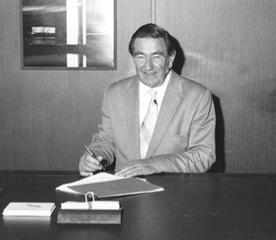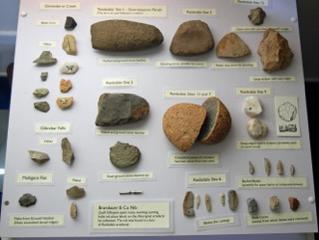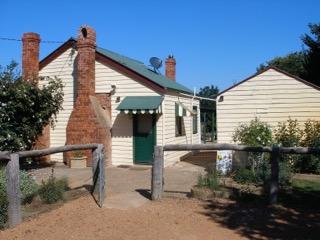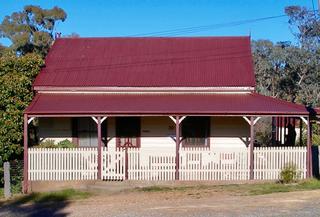The Gillespie Collection
The Hall Heritage Centre is custodian of the Gillespie Collection. Lyall's son Neil took this role after his father died in 2006, but passed the Collection to the Centre in 2015. It was Lyall's wish that as far as possible the Collection be kept together, and be made accessible. Here we record background information about Lyall and his pioneering family, his life work and the Collection that he assembled over the years.
Additional images may be found in our Gillespie Collection photo gallery
1. Lyall L Gillespie ISO OAM

Lyall Gillespie, City Manager, ACT
Lyall Leslie Gillespie was born at 'Cooee' in Hall village on 23 July1919, the son of William Gillespie and Lilian (nee Reid). William Gillespie was a shearer and station manager. The family moved away shortly after Lyall was born, returning in 1926.
They purchased a block of land on the corner of Gibbes and Loftus Streets and built their family home 'Fairy Bower'.
Lyall attended the Hall Primary School from 1926 until he graduated and then attended Telopea Park High School in Barton. Lyall was a very good and keen scholar who rode his bicycle every day from Hall to school at Barton. Later on he rode a BSA motorcycle. The Gillespies moved from Hall in 1939 and rented out their home during the war years. It was sold in 1945 to Jim Rochford.
After receiving his Leaving Certificate, Lyall joined the Public Service and commenced work in the Stores Department. Still keen on study, he began an accountancy course by correspondence.
On 6 September 1941 Lyall married Norma Joan Bogg at St. Andrew's Presbyterian Church in Goulburn. At the outbreak of the second world war Lyall was not released to join up and continued in the Public Service until Japan entered the war and then he joined the RAAF. He was trained in radar and radio communications. He was posted to Nookanbah in north- western Australia in 1943 to set up a radar station. He was also posted to Yanchep. DeGrey River, New Guinea and to the Admiralty Islands. During these postings he mixed with the local indigenous peoples and took a great interest in their cultures and formed many friendships.
After the war Lyall returned to the Public Service and was employed in a number of departments until 1960. From 1960 he was the Assistant Administrator of the Northern Territory. He returned to Canberra in 1963 as Assistant secretary of the Department of the Interior where he helped oversee the work of surveying parties in Arnhem Land, work which eventually led to the establishment of Kakadu National Park.
His last position in the Public Service in Canberra was as City Manager, a post he held from 1978 till 1982. For his 45 year public service he was awarded the Imperial Service Order.
Lyall was an acknowledged expert in local history and was the author of a number of books on the region from aboriginal occupation to the 20th century. He was also a keen gardener and won a number of awards at the Canberra Show for his flowers.
Lyall was the son of William Gillespie and the grandson of James Gillespie who wrote articles for local newspapers under the pseudonym "The Wizard" James was the son of John and Mary Gillespie, bounty migrants arrived in Australia in 1811 and later settled in Ginninderra. (see below for their history). Lyall passed away on 24 January 2006.
(Note: The above information has been taken in large part from Lyall's obituary written by noted Canberra historian Jill Watrehouse.)
2. The Gillespie Collection

Part of a large aboriginal stone artefact collection
Neil Gillespie, son of Lyall Gillespie, donated to the Centre all of Lyall's research papers, books, artefacts, artworks and photographs in 2015 on the understanding that the collection be made available to the public and kept together where possible.
Neil made the decision to donate the extensive collection to the Hall Heritage Centre as his father lived in Hall as a boy and went to Hall School. Also a large amount of Lyall's research centred on the Ginninderra/Hall district.
The collection consists of many thousands of items that record the history of Lyall Gillespie the man, his working life, his extensive research, his family history, his hobbies and his awards and the recognition he received for his life's work.
The collection includes over 40,000 index cards each recording fastidiously the subjects of his historical research, his research papers, the extensive photograph collection, his aboriginal artefacts and tools, shells, books, artworks and farm tools and homemade radios.
3. The Gillespie family story

'Elm Grove'
John and Mary Ann Gillespie arrived in Sydney from Ireland on 11 November 1841 on the sailing ship 'Lascar'. They were brought to Australia under the bounty scheme. John was employed by William Klensendorlffe of the Limestone Plains (Canberra) and lived at Klensendorlffe farmhouse where their second son James was born.
John chose a site at 'Dead Horse Gully' near 'Giningininderry'. He and Mary Ann had two more sons William and Robert and a daughter Euphemia. The family then settled on land at the headwaters of Ginninderra Creek during this time. In 1852 he purchased the land and built a stone cottage and other structures. This was the first free selection of land in the Ginninderra district. John continued to purchase additional blocks of land and became a substantial landholder in the district. In later years his sons also added to the land holdings. The property was later named 'Horse Park'.
John is credited with introducing the first wagon to the district. He was also associated with the building of St Ninians Presbyterian Church in Canberra. He was very active in the Queanbeyan Branch of the Free Settlers Protective Association. John died at 'Horse Park' in 1889 and Mary Ann lived on there with her son William until her death in 1895. After Mary Ann's death 'Horse Park' was purchased by William Ryan until it was compulsorily acquired by the Commonwealth in 1911 as part of the establishment of the Federal Capital Territory.
James Gillespie was born at Klensendorlffe Farmhouse in 1844 and lived with his parents John and Mary Ann at 'Horse Park'. In 1862 James purchased land under the Robertson Land Act where he built a cottage. The property later became known as 'Elm Grove'. James married Isabella Hay Jones in 1882 and they had four children. James was very active in the district as Secretary of a number of sporting organisations and a member of political associations. He was also well known as being a regular writer of the 'Ginninderra Notes' for the Goulburn Penny Post as 'The Wizard'.
There were two fires at the 'Elm Grove' property. One in 1892 caused by a young William Gillespie playing with matches and a more serious one in 1911 where apart from the building a number of heirlooms and gifts were lost. James and Isabella stayed on at 'Elm Grove' as leaseholders after the property was compulsorily acquired by the Commonwealth.
James died in 1926 and Isabella in 1938. William Ernest Gillespie, one of James and Isabella's sons married Lilian Anne Reid and their first son was Lyall Leslie Gillespie.
4. A Hall connection
Lyall's parents were living in Hall, at 'Cooee' on Victoria Street when Lyall was born in 1919. The family then moved away from Hall to Queanbeyan and then to Wells Station. When Lyall was about seven years old they moved back to Hall to live at 'Fairy Bower' - 4, Loftus St. Lyall then became a pupil at Hall School until he was old enough to go to Telopea Park High. It has been a regular source of some amazement that initially he made the trip to Telopea and back on his bicycle! Later on he used a BSA motorcycle. It is very fitting that the collection of one of its most successful old boys should now be housed at the school which he attended almost a century ago.
5. Early education and schools of the Canberra district
In 1999 when Lyall published 'Early education and schools in the Canberra region' it was the first major work on schooling since it had begun 150 years earlier. While there is greater emphasis on schools within what is now the Capital Territory, the region studied extends from Yass in the north to Michelago in the south, and from Wee Jasper in the west to the Shoalhaven River in the east. The period covered is approximately the century from 1840 to 1940 - from the first Church of England schools to open at Queanbeyan, Ginninderra and Canberra to the foundations of a modern education system for Canberra.
Within these borders of time and space Gillespie recorded essential details of 181 schools - from Acton to Yumburra West - and for most of them, reports something of their special stories, which are illustrated with around 100 photographs, drawings and sketch maps. Thanks to the records kept by the NSW State Archives he also listed the more that 1,000 teachers who taught at the schools in question, and has colourful sketches of many of them. The great majority of the schools included are small, one-teacher 'bush schools' which were relatively short-lived. Their numbers grew rapidly after the Public Instruction Act (1880) introduced compulsory schooling, peaked in 1913, and were falling quite rapidly by the 1920's as motor transport enabled centralisation.
While the core of his book is an indispensable compendium for anyone with an interest in these early schools, it also incorporates an overview of main developments in the history of the NSW education department.
The book has been the foundation for two exhibitions presented by the Centre. In 2012, following the Hall Public School Centenary celebration in the previous year, the Centre presented an exhibition on 'Bush schools of the Hall district', featuring twenty schools within a radius of around ten miles from Hall. This created such interest that in 2013, the Canberra Centenary year, a second exhibition, featuring schools within the Capital Territory borders, was presented - 'Present at Birth. Schools and Teachers of the Capital Territory, 1913'. Both exhibitions drew heavily from Gillespie's work.
A grant from the ACT and District Heritage Council for the second exhibition included funding for an on-line database on the early public schools of the Canberra district. This database - 'Early Capital Territory and district government schools and teachers' now has entries for more than 80 schools and around 600 teachers. It includes 230 photographs, and incorporates links to a large number and range of external sources.
6. Ginninderra - Forerunner to Canberra
Ginninderra. Forerunner to Canberra, Lyall's study of the origins and development of Ginninderra, published in 1992, is a major work of local history. Its thesis is in the title; Ginninderra predated Canberra - by nearly a hundred years - and its early settlers led the way in developing a successful way of life on the Limestone Plains. In the earliest years of settlement the centre of modern Canberra was taken up by a relatively small number of very large land holdings, Campbell's Duntroon being the best known. This was less the case at Ginninderra, and the Robertson Land Acts of 1860 enabled a lot of smaller farmers to purchase land and establish homes.
Lyall's 'history of the Ginninderra district', after acknowledging the aboriginal prehistory, recounts developments from George Palmer's establishment of 'Palmerville' (c.1826) to the resumption of land by the Commonwealth (from 1911). This is in part a familiar settler history, relating the stories of the Palmers, William Davis, Henry Hall, the Craces, the McCarthys and others, and their efforts to make the unfamiliar soils and climate productive, followed by the much larger numbers of selectors on their much smaller holdings - the Shumacks, Gillespies, Rolfes, Coultons, Camerons, Kilbys, Southwells and Smiths in the second half of the nineteenth century. Inter-marriages amongst these families produced the next generation, who consolidated their gains and established Ginninderra as a well-renowned agricultural district.
Palmerville was the embryo for Ginninderra. Many of the Palmer's employees, and former convicts, went on to establish farming and other enterprises of their own. Palmerville gardener Edmund Ward establisheded a nursery; accountant George Harcourt became a store owner and farmer. This genesis, and subsequent growth of the putative village of Ginninderra along the Queanbeyan-Yass road, led, according to Gillespie, to the Ginninderra's 'heyday' when William Davis was the 'Squire'.
The book chronicles the history of all the Ginninderra institutions - police station, church, school, School of Arts, the Cricketers Arms hotel, the Ginninderra show, sports teams - and the social and recreational life of the community - the balls, shooting parties, picnics, weddings and funerals, and celebrations of great national occasions. Chapters on mining in the district, political activity, the environment, murders and other tragedies broaden and enrich the story.
Although Ginninderra was in many ways still developing, the departure of William Davis in 1877 seems to mark an inflection point. The new village of Hall was proclaimed in 1882 and the 1890's was a decade of rural depression. In 1908 Canberra was selected as the site of the future capital and the land was ceded by New South Wales to the federal government. The text concludes with some reflections on Ginninderra after acquisition when 'Canberra takes over'.
The book continues for a further eighty pages however. In addition to the very detailed index and bibliography there are nine appendices, some of which list comprehensively the Ginninderra police officers, postmasters, and teachers, burials at The Glebe, and licensees of the Cricketers Arms. Another - a major research achievement by itself - proffers biographical notes on 563 'early residents and landholders of the Ginninderra district'. Some are one-liners; others quite extensive. Collectively they populate Ginninderra with the convicts, squatters, aboriginals, selectors, sportsmen, teachers, enlistees, labourers, shepherds, horse breeders and racers, mothers and children who bring Ginninderra to life and help us understand where we have come from.
Our 2015 exhibition 'Rediscovering Ginninderra' drew extensively on 'Ginninderra. Forerunner to Canberra', the photos, research notes and maps that it was based on. The subsequent on-line database of the same name extends well beyond the coverage of that exhibition - and continues to grow. The book unfortunately is out of print; we hope that 'Rediscovering Ginninderra' on-line will be seen as another way of getting to grips with the Ginninderra story.
A selection of images from our exhibition 'Rediscovering Ginninderra' can be found here




![Teacher and pupils at https://heritage.hall.act.au/school/1245/mugwill-school.html[Mugwill Public School], c. 1917](/images/small/article__gillespie.html_PHOTO9.jpg?120818)
![Ginninderra Store and Post Office. https://heritage.hall.act.au/display/1939/person/1954/george-harcourt.html[George Harcourt] with the paper under his arm.](/images/small/article__gillespie.html_PHOTO11.jpg?120818)